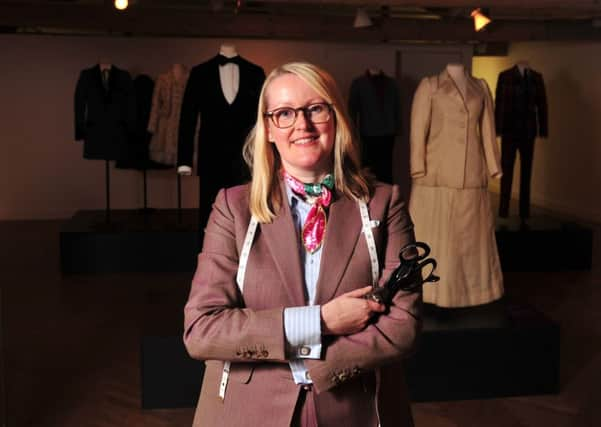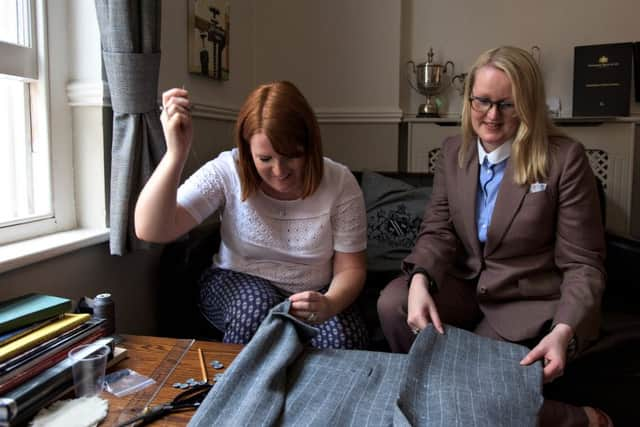Tailor maid: Cutting a dash in the rag trade


She’s back in her home city to open a new exhibition celebrating the country’s rich tailoring history. It features exhibits ranging from a child’s silk coat dating from the 1700s to a 1920s dress suit made by Leeds firm Burtons and with Sargent contributing one of her own designs, she hopes it will be a platform to champion a still thriving industry.
“It looks fantastic, doesn’t it?” she says getting her first glimpse of Tailored: A Very British Fashion, which has been curated by Ruth Leach and features garments by both Vivienne Westwood and Alexander McQueen. “British tailoring is among the best in the world. It always has been, but I think there is a tendency to think that the country’s textile industry has been consigned to history. That’s simply not true. Admittedly there might not be as many mills as there once were and the big manufacturers like Burtons and Hepworth’s, which were both major employers in Leeds, may be no more, but there are still some great firms producing some of the finest cloth in the world.”
Advertisement
Hide AdAdvertisement
Hide AdCloth made by Dugdale Bros and Co lines the walls of the gallery and the Huddersfield firm has a long relationship with Sargent who has brought a little bit of Yorkshire to London’s tailoring hub.


“I use their cloth because it’s incredible quality and just fantastic to work with, but the history is also important. Dugdale was founded in the late 19th century and I’m really quite proud to be another small chapter in their story.”
When Sargent was growing up in Leeds she knew from an early age that she wanted to work in the fashion industry, but it was only when she headed south to study at the Institute of Art and Design in Epsom that she discovered her passion for tailoring.
“None of my family worked in tailoring, although my dad always did have an eye for a good made-to-measure suit. As a little girl I would go with him to the tailors and maybe it was on those Saturday afternoons that the seeds of my later career were sown. I enrolled on a fashion course, but quite quickly I realised that what really interested me was tailoring. I think it was something to do with the precision and the structure of the pieces you could create.”
Advertisement
Hide AdAdvertisement
Hide AdAfter graduating in 1996, Sargent got her first job at tailors and shirtmakers Denman and Goddard before moving to No 1 Savile Row, the home of Gieves & Hawkes. At the time, the tailoring industry was still very male dominated, but determined to make her mark she soaked up the knowledge of those with decades of experience of seams, pleats and cuffs and the hard work paid off. In 2009, Sargent became the first female head cutter to work on Savile Row and in the years that followed she has seen more women follow her into the industry.
“Savile Row was quite an exclusive little club when I was on the first rung of the ladder. There also weren’t many young people coming into tailoring and there were even less women. I suppose it was quite a challenging environment, but in some ways that counted in my favour. I just knew where I wanted to be and I basically bowled up at Gieves & Hawkes and asked for a job.
“Working for such an established company was a huge learning curve, but I reckoned that you might as well start at the top and they really did take me under their wing. I started lining collars, making pockets and running errands. I didn’t mind, I just wanted to learn every part of the business.
“When I look at Savile Row now it’s changed completely. In the past, women tended to occupy the backroom roles, finishing off buttonholes and sewing the linings. Now the whole business of tailoring has opened up and it does seem to be attracting more and more women into the top positions.”
Advertisement
Hide AdAdvertisement
Hide AdAfter learning her trade, in 2012 Sargent took the next step by launching her own label which now operates out of Mayfair. It might just be a short hop from Savile Row, but it has allowed her to set up a bespoke service which blends the traditional with the contemporary.
“We don’t have what you would call a house style. One of the things I have always really enjoyed doing is working with everyone who comes through our door to create a suit which is absolutely unique to them.
“That really starts with the showroom. I didn’t want it to feel intimidating, instead the idea was that it should feel more like a luxury hotel suite, somewhere people can come and immediately feel relaxed.”
Those making their first appointment at Sargent’s emporium are greeted with big comfy sofas, wooden bookshelves lined with coffee table photographic books and of course, fresh flowers.
Advertisement
Hide AdAdvertisement
Hide Ad“The best bespoke tailoring is a real collaboration between the tailor and the client,” she says. “I want them to tell me what they like, but I also want them to feel they can take on board my suggestions. It’s about accentuating what they like about their shape and hiding the things that they don’t.”
The first consultation can take up to three hours. Aside from the 25 measurements that need to be correctly recorded for the perfect suit, Sargent also makes sure that she knows a little about the lifestyle of those she works for, to ensure that the final suit is both stylish and practical.
“Simple things, like do they travel a lot, will they want to wear it in hot temperatures, can really affect the choice of material and the design. I want them to feel comfortable, but I also want to ensure that they have a suit which doesn’t just look good now, but looks good in five, 10 or 20 years time.”
That type of durability doesn’t come cheap. Like all of the top bespoke tailors, a Kathryn Sargent suit costs thousands, but calculate the cost per wear and it starts to look a whole more reasonable.
Advertisement
Hide AdAdvertisement
Hide Ad“In the past couple of decades we have grown used to cheap, almost disposable clothing, items which you can forget about after wearing just once or twice. It never used to be like that and that’s one of the things I really want to remind people. A typical suit takes 50 hours to complete and as many as eight different people can be involved in its creation. It’s craftsmanship and you pay for what you get.
“If you do invest in a good suit, you’ll have it for a lifetime. There has been a bit of a renaissance in British tailoring in the last few years and we now see a lot of young professional men with a real sense of style coming into our showroom.”
Sargent’s clients have ranged from members of the Royal Family to celebrities, including David Beckham, although she’s too discreet to admit to any difficult customers.
“Honestly, every day I look forward to going into work because you never know what it will bring. Some of our clients come to us every few years for a special outfit, while others want us to create an entire wardrobe for them and while the vast majority of our customers are men we are seeing more women come through the door.”
Advertisement
Hide AdAdvertisement
Hide AdBack at the exhibition in Leeds, Sargent gives a short demonstration of her cutting skills, carefully marking up a section of high-end Dugdale cloth. She makes it look effortless, but as anyone who has ever dabbled in pattern cutting knows, one wrong move at this stage can throw the whole garment out.
“This is one of the most important exhibitions I could have ever wanted to have been involved in and it feels a real privilege to have one of my suits sit alongside some of these iconic designs,” she says.
“When the museum first contacted me about being involved they said they wanted to tell the story of British tailoring, how firms like Burtons took it to the mass market and how the kind of craftsmanship which began hundreds of years ago is still in evidence today.
“I think that’s really important. When it comes to tailoring, Britain boasts some of the best craftsmanship in the world and we ought to shout about it. My mum still lives in Leeds and she often says to me: ‘Kathryn, why don’t more people up here know about how well you’ve done?’ This exhibition isn’t about me, but it is a real celebration of an industry which has much to be proud about.”
Advertisement
Hide AdAdvertisement
Hide Ad• Tailored: A Very British Fashion runs at Leeds City Museum until January 3 As part of the exhibition there will be a number of special events, including a guided tour of the exhibits on September 3 and October 22. For more details call 0113 224 3726, www.leeds.gov.uk/Tailored.